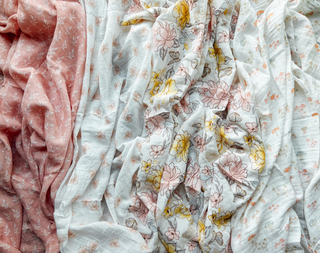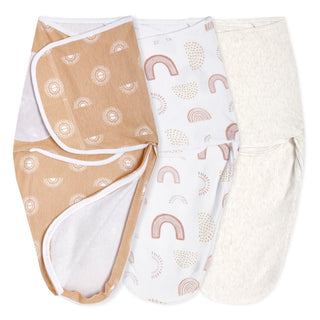Knowing how to swaddle a baby is an important (and potentially life-changing skill) to know, especially during the newborn phase! The great news is that if you’re curious about how to swaddle a newborn, all you truly need is a muslin swaddle blanket, a baby, and your two hands to get the job done.
You don’t need to figure out the best way to swaddle a baby on your own! We’ve provided step-by-step swaddling instructions for parents to help them make sure they do it right, as well as answering some of the most common questions parents have about swaddling a baby.
What is Swaddling?
If you're a new or expecting parent, you may not know what exactly it means to swaddle a baby. It's a word that gets thrown around a lot with little explanation. We've got you covered!
Swaddling is an age-old practice of wrapping infants with a blanket snugly around their body. It is known for helping to soothe babies. Many believe that swaddling has such a calming effect on newborns because it mimics how they felt in their mother's womb. Little ones often find this comforting, and swaddling quickly becomes a parent's go-to to help their baby settle down, go to sleep, and stay asleep.
Another benefit to swaddling is that it helps prevent infants waking themselves with their moro reflex. The moro reflex (also known as startle reflex) occurs when there is a sudden disruption causing an infant to "startle". They react by throwing back their head, extending out their arms and legs, crying, then pulling the arms and legs back in.

featuring aden + anais organic cotton muslin swaddle in animal kingdom
How to Choose the Right Swaddling Blanket or Wrap
The right swaddle blanket or wrap can make a big difference in your baby's comfort and safety. Here are some factors to consider when choosing a swaddle blanket or wrap:
- Material: Choose a material that is soft, breathable, and gentle on your baby's skin. Popular material choices are cotton, bamboo, and muslin. You can even find certified organic swaddle blankets that are free of toxins.
- Size: Swaddles come in a variety of sizes but most are between 40 and 48 inches square. Consider the size of your baby and the level of swaddling you want to achieve when choosing a swaddle blanket or wrap. Some wraps are specifically designed for newborns, while others can accommodate larger babies.
- Type of Swaddle: There are two main types of swaddles; traditional swaddles and swaddle wraps. Traditional swaddle blankets require some skill to wrap correctly, but they offer more customization in terms of tightness and fit. Swaddle wraps, on the other hand, are easier to use and often come with fasteners or hook and loop closures to secure the wrap in place.
- Safety: Avoid blankets with loose or dangling fabric, as these can be a suffocation hazard. Make sure the wrap fits snugly around your baby's body without restricting movement or breathing. It is also recommended to choose a swaddle that is hip healthy. Hip healthy swaddles are designed to allow natural hip positioning.
Top Cotton Muslin Swaddle Blankets
How to Swaddle a Baby
Now, it’s time to answer that burning question of, “how to swaddle a baby?” Follow these swaddling instructions to make sure your little one is wrapped up safely:
Step 1

Remember, we recommend swaddling a baby with a muslin blanket. Get it out and fold the swaddle into a triangle by folding back one corner. Place your baby in the center with the shoulders just below the folded corner.
Step 2

Place your baby’s right arm alongside the body, slightly bent. Take the same side of the swaddle and pull it securely across your baby’s chest, keeping the right arm under the fabric. Tuck the edge of the swaddle under the body, leaving the left arm free.
Step 3

Fold the bottom corner of the swaddle up and over your baby’s feet, tucking the fabric into the top of the swaddle by their shoulder.
Step 4

Place your baby’s left arm alongside the body, slightly bent. Take the same side of the swaddle and pull it securely across your baby’s chest, keeping the left arm under the fabric. Tuck the edge of the swaddle under their body.
Our favorite swaddles
Swaddling Alternatives
Swaddling is a popular technique for calming newborns and helping them sleep better. However, some parents prefer not to swaddle or may find that their baby doesn't like it. Here are some swaddling alternatives to consider:
- Sleep Sacks: Sleep sacks are a popular alternative to swaddling, providing a secure and cozy environment for your baby without restricting movement. And they come in different sizes and materials.
- Swaddle Transition Products: As your baby grows and becomes more active, you may want to transition away from traditional swaddling. There are several products available, such as wrap swaddles that provide different swaddling options; arms in, one arm out, both arms out.
- Co-Sleeping: If you're comfortable with co-sleeping, you can create a safe sleeping environment by using a co-sleeping bassinet or bedside sleeper. This allows your baby to sleep close to you while still having their own safe sleeping space.
Top Easy Wrap Swaddles
Common Swaddling Mistakes
Swaddling mistakes happen, especially to new parents who have never swaddled a baby before! Don't you worry, we have your back. Here is a list of the common swaddling mistakes and how to fix them.
- Wrapping baby too tight. This can restrict baby's movements and sometimes even their breathing depending on how tight the swaddle is. Make sure the swaddle is snug but not too tight, leaving room for their legs to move and space to breathe comfortably.
- Not leaving enough room for hips. It is important to leave space for baby's hips to move freely to help prevent hip dysplasia, a condition where the hip joint doesn't develop properly. To fix this, make sure the swaddle leaves enough room for hips and legs to move freely and comfortably.
- Swaddling too high on the chest. This can increase the risk of baby overheating. To prevent this, make sure the swaddle is wrapped securely around their midsection, leaving upper chest and neck uncovered.
- Using the wrong size blanket. If the blanket is too big or too small, swaddling will not work. Swaddles come in a variety of sizes but most are between 40 and 48 inches square. Choose the size swaddle based on the size of your baby.
- Not checking the baby's skin temperature. Overheating can increase the risk of SIDS (sudden infant death syndrome). To fix this, you can check the baby's temperature regularly and adjust the swaddle and clothing layers as needed. HALO SleepSure Smart Baby Monitor is a parent favorite when it comes to monitoring baby. It tracks 4 key sleep measures, including skin temperature! You can conveniently keep check on your baby's temperature from your phone, without having the wake baby up throughout their sleep!
When to Stop Swaddling
It is generally recommended to stop swaddling a baby when they start to show signs of rolling over independently, which typically occurs around 4-6 months of age. Swaddling can restrict movement and make it difficult for a baby to turn over, increasing the risk of suffocation or other safety concerns.
Once your baby is showing signs of rolling over, it's time to transition to a different sleep routine. You can start by swaddling with one arm out, then gradually moving to both arms out, or switching to a sleep sack or other alternative sleepwear.
Remember, every baby is different, and some may transition out of swaddling earlier or later than others. It's important to monitor your baby's development and adjust your sleep routine accordingly to ensure their safety and comfort. If you have any concerns or questions, consult with your pediatrician.















































